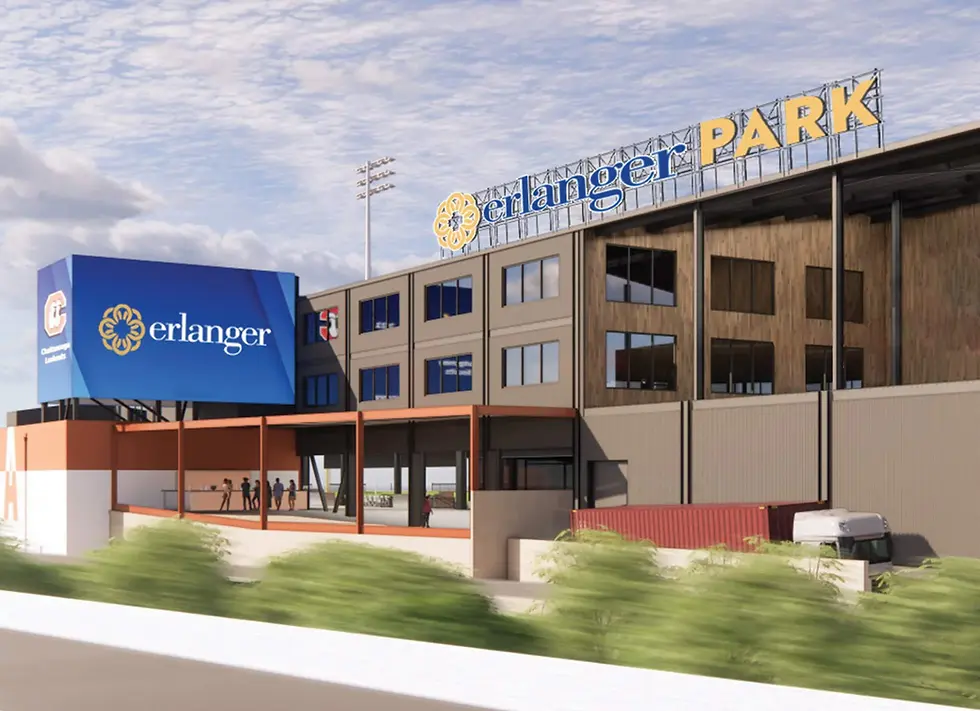Hap Bruno Field: A Chicago Heights Legacy
- Marc Viquez

- Jul 2
- 3 min read
Updated: Aug 27

If you ever pass it on your way through town, the old grandstand on the corner of Chicago Road and Dixie Highway has been there for almost a century. They call it Hap Bruno Field, but the large sign above the entrance reads Chicago Heights Park Department. Little does anyone realize that the ballpark and town have quite the history of baseball.
Semi-pro baseball has a long history in town that dates back to 1894. A ball field on 17th and East End Avenue was used for games from 1898 until a group of 1,094 people formed the Chicago Heights Athletic Association and financed the $25,000 modern grandstand in 1927. The grandstand offered 196 box seats and 25 boxes that would also house football and ice skating in the winter.
“There wasn’t a single dime of public money [used to build the ballpark],” said Bruno in a 1980 radio interview. “It was all through public subscription (tax money). No contributions from any political division. The only thing you did was approach your friends on season tickets, those who would help support the program.”
The first game took place at CHAA Field on October 6 of that year with a crowd of 4,000 people welcoming the new baseball plant with a motor car parade through downtown. The visiting Hammond club won the game 5-3.

There were various semi-pro teams played in town and at the ballpark at times, including the Cyclones, Boosters, Owls, and Arrows, along with a manufacturing team called Lincoln AC. The Chicago Heights Athletic Association played off the ballpark until midway through the 1938 season when it dropped out of playing baseball. The ballpark would be used by Arrows in 1939 and the Owls in 1939.
The Owls joined the newly formed Greater Chicago Semi-Pro Baseball League.in 1947 under the management of Mario “Hap” Bruno. The 10-team loop’s purpose was to Promote a better brand of semi-pro baseball for the fans and the greater Chicago area and to help organize hardball for the better interest of the game itself. The high quality of baseball stretched from organized teams like the Chicago Heights A’s and Skokie Indians to company teams from RCA Victor and Lorenz Steel.
This was a league that featured former major league ballplayers and included traveling teams. The goal was for every team to have a ballpark similar to CHAA Field and have it packed with fans for every home game on Sunday. The first few seasons of the league saw big crowds in the stands, and the Chicago Heights team captured the 1948 league championship.
“Chicago Heights stands to enjoy a period of prosperity and player development which will be the greatest in the history of the game in these parts.”

The team would become the A's and was managed and financed by Bruno, with a volunteer crew helping with preparing the field, handling ticket sales, parking cars, and shagging foul balls. Fans packed the stadium for Sunday games, but by 1952 an average of 25 fans regularly attended games and volunteers disappeared leaving Bruno as a one-man crew handling the operation of the team.
The team needed 100 fans per game at $1.00 admission to pay for the baseballs and umpires. Only one player, pitcher Frank Verka, was being paid, and all other players wanted to start or they wouldn’t show up for games. It led to Bruno folding up the A’s in April of 1953 and after 69 years, semi-pro baseball was over in Chicago Heights.
The following year a six-team VFW circuit was formed along with one night of a Rotary-Lion's Teen circuit. The fees from the VFW helped provide money to maintain the grandstand that needed light repairs. Bloom Township High School still uses the stadium which was the former home of the Southside Vikings of the Northern League.

The Chicago Heights Park District renamed the field to Hap Bruno Field in 1996. At the time, Bruno was 91 years old and still sharp on his memories of the game that dated back to the 1920s. He would pass away one year later but left a lifetime of memories in town.
The old ballpark looks a little banged up and weathered, but for a structure that is 98 years old, she has a lot of life left in her. It might not be much to the many who pass by daily, but it has a story to tell. Perhaps a form of summer baseball will return to continue the tradition set by members of the Chicago Heights Athletic Association almost a century ago.
------
Follow all of Marc’s stadium journeys on Twitter @ballparkhunter and his YouTube channel. Email at Marc.Viquez@stadiumjourney.com







Comments